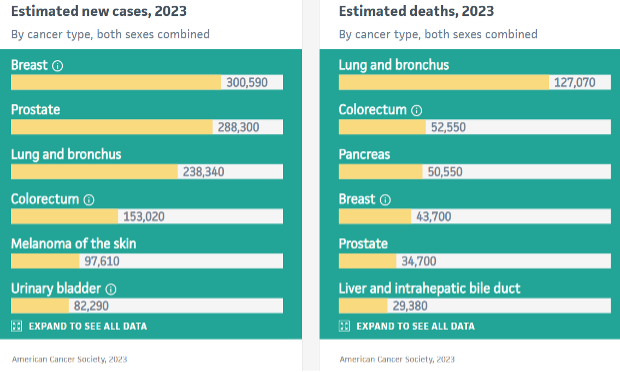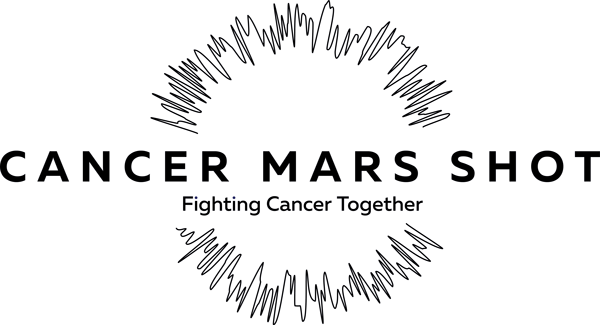Cancer Statistics, History of Blood Cancer, and the Role of Biobanking

Introduction
According to the World Health Organization (WHO), cancer accounted for nearly 10 million deaths worldwide in 2020 alone.1 This devastating disease can affect any part of the body, occurring when abnormal cells become dysregulated and begin to grow and spread uncontrollably. However, to fully recognize its burden and succeed in cancer research, we must first understand global cancer epidemiology because it provides important trends and patterns on the incidence, mortality, and survival rates of different subtypes.2 In this article, we present an in-depth discussion of recent worldwide cancer statistics, review the evolution and history of blood cancer and other cancer types, as well as emphasize the crucial role of biobanking in advancing the development of oncology therapeutics.
United States Cancer Statistics (2023)
According to the American Cancer Society, nearly 1.96 million new cancer cases are projected to be diagnosed in the United States in 2023, an increase from the 1.9 million new cases estimated by sources of cancer statistics (2022).3,4
Figure 1 lists the six most common cancer types diagnosed, as well as the leading causes of cancer death in the U.S., estimated for 2023 [3].

Incidence and Mortality Rates
Sung et al. (2021) presented the most recent estimates of incidence and mortality worldwide across 185 countries using data from Global Cancer Statistics (GLOBOCAN) 2020.5 GLOBOCAN 2020 estimated that over 19 million new cancer cases and approximately 10 million cancer deaths to have occurred in 2020; by 2040, the global burden of cancer is expected to be 28.4 million cases, nearly a 50% increase from 2020 statistics.5
Figures 2 and 3 provide an overview of global incidence and mortality data, respectively, organizing cancer rates by country, cancer type, and gender.


Survival Rates by Cancer Type
Despite the climbing prevalence of the disease, cancer survival rates have similarly increased in recent years due to advances in cancer treatment methods, although there is significant variation in survival rate by cancer type, region, and stage at diagnosis.6
Using the United States as an example, the cancer types most commonly associated with death in the country, as shown in Figure 1, were reported to have the following survival rates, based on data from Siegel et al. (2023): prostate cancer survival rate (97%), breast cancer survival rate in females (91%), survival rate for melanoma of the skin (94%), colon cancer survival rate (63%), survival rate of lung cancer (23%), and pancreatic cancer survival rate (12%).7 These are all notable improvements from preceding statistical evidence.7
The History of Blood Cancer Treatment
Ancient Times
The earliest recorded cases of cancer date back to ancient Egypt, where the methods of treatment included surgery, cauterization, and the use of herbal remedies.8 In ancient Greece, treatment methods in ancient Greece included surgery, herbal remedies, and dietary changes.9
19th and 20th Centuries
In the 19th century, advances in surgical techniques and anesthesia led to more successful cancer surgeries.10 Soon after, in the 20th century, radiation therapy was developed, which allowed for the destruction of cancer cells, although it was unable to spare healthy cells. Talking about the history of blood cancer, the first known case of Hodgkin lymphoma was reported in 1832, whereas the start of chemotherapy use in leukemia treatment history did not occur until the 1940s-1950s.11,12 Near the end of the 20th century, cancer treatment became more personalized, with the development of targeted therapy and immunotherapy.13
Modern Approaches in Cancer Management
Today, in the 21st century, cancer treatment is highly individualized, with a variety of treatment options available depending on the type and stage of cancer.14 Our increasingly complex understanding of cancer biology has led to a more personalized approach to cancer treatment. Personalized medicine uses a patient's unique characteristics, such as their genetic makeup, to tailor treatment to their specific cancer.
This emerging practice has shown promise in improving treatment outcomes and reducing side effects.15 For instance, CAR T cell therapy, which uses a patient's own genetically altered T cells to target cancer cells, has shown promising results in treating lymphoma and acute lymphoblastic leukemia (ALL). The remission rate among ALL patients treated with Kymriah, a CAR T cell therapy approved by the U.S. Food and Drug Administration, was about 85% through 2020, with more than half having no relapses after a year.16
Biobanking in Cancer Research and Treatment
A biobank is a repository that stores biological samples and associated data for research purposes.17 In cancer research, biobanks play a crucial role in biospecimen procurement, which provides researchers with access to high-quality biospecimens that are essential for studying disease mechanisms, genetics, and treatment responses.18
Collection, Storage, and Management of Biosamples
As outlined in Figure 4, biobanks collect various biospecimens, including tissues, blood, and other bodily fluids, from cancer patients and healthy individuals before being stored under carefully controlled conditions for applications in clinical research.19,20 More importantly, these cancer tissue samples and other biospecimens are ethically collected from consented donors, as explained here by Audubon Bioscience, a leading global biobank provider. Following human tissue collection or biospecimen procurement, advanced tracking and inventory systems are then used to manage the biosamples and ensure their traceability and quality.19

Role of Biobanking in Advancing Cancer Research
Biospecimen providers like Audubon Bioscience have significantly advanced cancer research by providing researchers with valuable biospecimens to study the biology, genetics, and treatment responses seen in cancer.21 Combined with the contribution of biobanks to the development of immune-based therapies and precision medicine, these organizations play an essential role in helping pharmaceutical sponsors develop targeted therapies to improve clinical outcomes in oncology patients.22
Key Benefits of Biobanking
The first benefit of biobanking is that it provides researchers access to a wide range of high-quality biological samples and associated data, enabling them to conduct cutting-edge research and accelerate the pace of discovery and innovation in healthcare.23
Second, by sharing their collections of biospecimens and associated data, biobanks facilitate diversity in clinical research by enabling the pooling of resources, expertise, and knowledge. This collaboration can lead to a more comprehensive understanding of diseases and their treatments.23,24
Lastly, biobanks provide drug development companies with a vast collection of biological samples to test the efficacy and safety of new drugs in large-scale experiments. This can help expedite the drug development process and lead to the creation of more effective treatments for a range of diseases.23
Key Challenges of Biobanking
Despite the positive impact, biobank providers must overcome certain challenges to maintain the value of their biospecimens. First, they must ensure patients have the opportunity to provide voluntary consent, as well as be adequately informed of the potential risks and benefits of participating in biobanking.23,25
Furthermore, because the quality of biological samples can affect the accuracy and reliability of research results, biobanks must take care to use specialized storage and preservation methods to ensure that samples remain viable and fit for use in research. Lastly, some additional challenges may include managing the cost of collecting and storing samples, the need for standardized protocols for sample collection and processing, and the potential for sample contamination.
The Future of Cancer Research and Innovations
Cancer continues to be a major health issue worldwide, affecting millions of people every year. However, advancements in cancer research and treatment are offering hope for better outcomes for patients in the future. Some of these emerging innovations include the following:
- Liquid biopsies, a new cancer management method that involves testing a patient's blood for cancer cells or biomarkers.26
- Genomic analysis to identify the genetic mutations that drive a patient’s particular cancer growth, leading to the development of precision therapies.27
- Immunotherapy, which uses the body's immune system to fight cancer cells, and has already shown significant promise in treating several types of cancer.28
Whether by enabling the identification of new biomarkers and therapeutic targets for novel cancer treatments or allowing the targeting of specific genetic mutations underlying cancer types, biobanking and biospecimen procurement companies will remain vital partners in the quest for curative therapies against cancer.
Conclusion
As our grasp of technology hopefully continues the trend of improving cancer survival rates, cancer statistics can further help inform public health policies, prevention strategies, and targeted research. Similarly, the historical evolution of cancer management highlights the significant strides cancer treatment strategies have made in the last 100 years alone. Lastly, at the heart of these medical advances lies biobanking, the role of which in cancer research has provided researchers with access to high-quality biological samples and genomic data, leading to the development of highly effective targeted therapies and personalized medicine.
As such, continued investment and development in biobanking and biospecimen procurement from companies like Audubon Bioscience will be essential in advancing cancer research and improving cancer treatment outcomes.
Visit our blood products page to find the right biospecimen for your next innovative project or contact our team of scientists to request a quote today!
References
- World Health Organization. Cancer. Published February 3, 2022. https://www.who.int/news-room/fact-sheets/detail/cancer
- Soerjomataram I, Bray F. Planning for tomorrow: global cancer incidence and the role of prevention 2020–2070. Nature Reviews Clinical Oncology. Published online June 2, 2021:1-10. doi: https://doi.org/10.1038/s41571-021-00514-z
- American Cancer Society | Cancer Facts & Statistics. American Cancer Society | Cancer Facts & Statistics. Accessed August 25, 2023. https://cancerstatisticscenter.cancer.org/?_ga=2.23788986.1431434335.1693517693-527327325.1691599705&_gl=1
- Cancer Facts & Figures 2022. www.cancer.org. Accessed August 25, 2023. https://www.cancer.org/research/cancer-facts-statistics/all-cancer-facts-figures/cancer-facts-figures-2022.html#:~:text=1%20Estimated%20numbers%20of%20new%20cancer%20cases%20and
- Sung H, Ferlay J, Siegel RL, et al. Global Cancer Statistics 2020: GLOBOCAN Estimates of Incidence and Mortality Worldwide for 36 Cancers in 185 Countries. CA: a Cancer Journal for Clinicians. 2021;71(3):209-249. Doi: https://doi.org/10.3322/caac.21660
- Advancing Cancer Therapy. Nature Cancer. 2021;2(3):245-246. doi: https://doi.org/10.1038/s43018-021-00192-x
- Siegel RL, Miller KD, Wagle NS, Jemal A. Cancer statistics, 2023. CA: A Cancer Journal for Clinicians. 2023;73(1):17-48.
- Cancer as ancient Egyptians knew and understood it. Cancer History Project. Accessed August 28, 2023. https://cancerhistoryproject.com/article/cancer-as-ancient-egyptians-knew-and-understood-it/
- History of Cancer. The Cancer Atlas. Accessed August 28, 2023. https://canceratlas.cancer.org/history-cancer/#:~:text=Surgery%20and%20cautery%20were%20used%20on%20smaller%20tumors.
- 19th Century. The Cancer Atlas. https://canceratlas.cancer.org/history-cancer/19th-century/
- The curious case of blood cancers and their treatment breakthroughs. www.nccs.com.sg. Accessed August 28, 2023. https://www.nccs.com.sg/patient-care/Pages/The-curious-case-of-blood-cancers-and-their-treatment-breakthroughs.aspx#:~:text=After%20Sir%20Thomas%20Hodgkin%20first%20reported%20a%20group
- Leukemia Treatment. Overarching Questions. Published September 14, 2017. https://serc.carleton.edu/woburn/overarching/leuk_treatment.html
- 20th Century. The Cancer Atlas. Published 2012. https://canceratlas.cancer.org/history-cancer/20th-century/
- 21st Century. The Cancer Atlas. https://canceratlas.cancer.org/history-cancer/21st-century/
- Personalized Medicine. Genome.gov. https://www.genome.gov/genetics-glossary/Personalized-Medicine#:~:text=Personalized%20medicine%20is%20an%20emerging%20practice%20of%20medicine
- Daley J. Four Success Stories in Gene Therapy. Nature. Published online October 26, 2021. doi: https://doi.org/10.1038/d41586-021-02737-7
- Harati MD, Williams RR, Movassaghi M, Hojat A, Lucey GM, Yong WH. An introduction to starting a biobank. Methods in molecular biology (Clifton, NJ). 2019;1897:7-16. doi:https://doi.org/10.1007/978-1-4939-8935-5_2
- Malsagova K, Kopylov A, Stepanov A, et al. Biobanks—A Platform for Scientific and Biomedical Research. Diagnostics. 2020;10(7):485. doi:https://doi.org/10.3390/diagnostics10070485
- Redrup MJ, Igarashi H, Schaefgen J, et al. Sample Management: Recommendation for Best Practices and Harmonization from the Global Bioanalysis Consortium Harmonization Team. The AAPS Journal. 2016;18(2):290-293. doi:https://doi.org/10.1208/s12248-016-9869-2
- Brain Tumor Ireland Bio-bank – Centre for Systems Medicine. Accessed August 31, 2023. https://www.systemsmedicineireland.ie/brain-tumor-ireland-bio-bank/
- Iudchenko A. How Cancer Research Depends on Biospecimens? High-Quality Human Biospecimens | Audubon Bioscience. Published March 16, 2021. Accessed August 31, 2023. https://audubonbio.com/blog/cancer-research-depends-on-biospecimens/
- Kraus VB. Biomarkers as drug development tools: discovery, validation, qualification and use. Nature Reviews Rheumatology. 2018;14(6):354-362. doi: https://doi.org/10.1038/s41584-018-0005-9
- Iudchenko A. Perspectives on Biobanking: Current Challenges and Future Directions. High-Quality Human Biospecimens | Audubon Bioscience. Published May 25, 2022. Accessed August 31, 2023. https://audubonbio.com/blog/perspectives-on-biobanking-current-challenges-and-future-directions/
- Kinkorová J. Education for future biobankers - The state-of-the-art and outlook. EPMA Journal. 2021;12(1):15-25. doi: https://doi.org/10.1007/s13167-021-00234-5
- McGuire AL, Beskow LM. Informed Consent in Genomics and Genetic Research. Annual Review of Genomics and Human Genetics. 2010;11(1):361-381. doi: https://doi.org/10.1146/annurev-genom-082509-141711
- Liquid Biopsies for Cancer: What to Know and What to Expect. Cancer.net. Published November 3, 2022. Accessed August 31, 2023. https://www.cancer.net/blog/2022-11/liquid-biopsies-cancer-what-know-and-what-expect#:~:text=A%20liquid%20biopsy%20is%20a%20blood%20test%20that
- Nogrady B. How cancer genomics is transforming diagnosis and treatment. Nature. 2020;579(7800):S10-S11. doi: https://doi.org/10.1038/d41586-020-00845-4
- Lee S. Immunotherapy. Canadian Cancer Society. Published 2011. https://cancer.ca/en/treatments/treatment-types/immunotherapy

